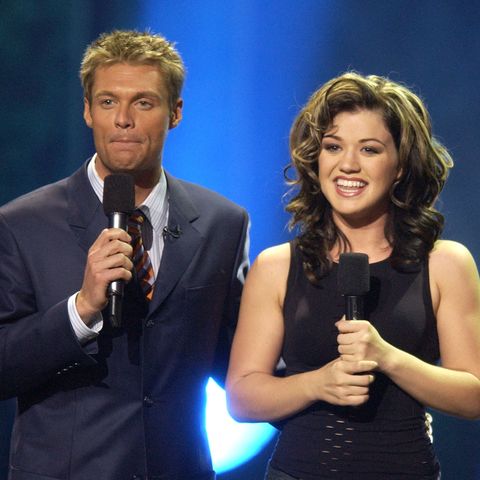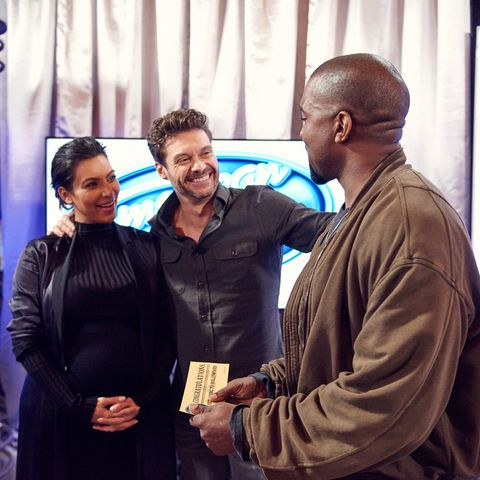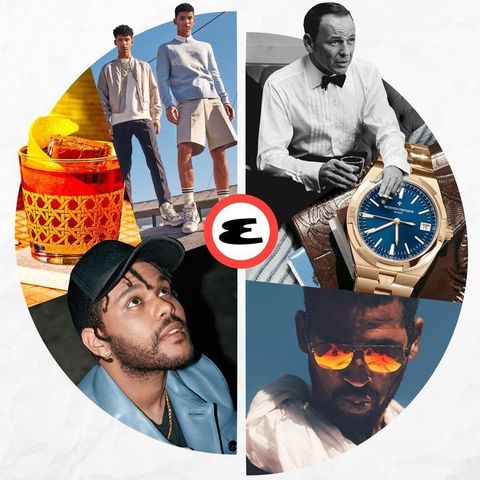This must be what it’s like to be eliminated from American Idol. Ryan Seacrest is in the middle of telling me about how the New Year’s Eve ball will drop this year, and then at the end of the sentence, silence. Ryan? I just stare at my phone for a while. Dim the lights. Signal dropped. Seacrest out. I mean, sure, he’s on a jet, which is a glitchy way to do an interview, but I’m oddly panicked. My head knows that Ryan—why am I calling him Ryan?—has not hung up on me, but my heart says otherwise.
A few seconds later, FaceTime audio lights up again. Seacrest is calling me back. This shouldn’t be a surprise because this is an interview about New Year’s Eve, and we’ve barely discussed it, but still. It feels special. “I spend half my life at 40,000 feet,” he tells me, apologizing for losing signal while in a different layer of the atmosphere. His plane is headed to New York City. This is where home is, along with the set of Live with Kelly and Ryan. It’s also the home of Times Square, where Seacrest has spent every New Year’s Eve for the past 16 years. Last year, nearly 18 million people watched him usher in 2020 from their homes. Scores more watched in person, unaware that in three months, the whole world would be homebound and quarantined due to the novel coronavirus. And yet, a year later, he knows keeping some form of New Year’s Eve on the table is crucial. His last act of 2020 is to make 2021 feel more bearable.
That’s because Seacrest understands how powerful the personal is. After more than three decades of experience, he’s in the air, taking interviews as he flies over states filled with people who adore him. They hope for an opportunity to meet him, whether they’re getting a golden ticket to Hollywood or a seat in his studio audience or a handshake on New Year’s Eve. To meet Ryan Seacrest means something good might be ahead. It might mean you’re someone, or at least you’re made to feel like someone. For Seacrest, all of this is The Good Thing: it’s what he wanted since he was a kid. But he’s keenly aware how quickly his type of position can disappear. so no matter how much is going on, no matter the strain, he’ll do what it takes to be your guy.
“Hey, so I was reading, you’re from East Tennessee?” Subjects do not do any homework on you. It’s not their job. “I mean, I hear a little accent only because I’m from Georgia so I can recognize it pretty quickly,” he says, with not an ounce of Southern twang in his delivery.
I’m not saying Seacrest is full of it—he legitimately is from Dunwoody, a suburb outside of Atlanta. It’s just that when the accent goes, so often does the affinity for it. We talk about Tennessee just long enough that it feels like we’re nearing friendship, and then we turn back to New Year’s. “I was speaking to [Jennifer Lopez] on the phone two days ago,” he says, casually. “And she said she wanted to be there because it’s such an important year to celebrate the people of New York.” I assume he has her personal number. I imagine what it might be like to be in his contact list. Do you think it’s exclusive enough that Kirkland might come right before Lopez? That’s the allure of Seacrest, I guess—this idea that he might know you. He has that way—that way of making the conversation about someone else.
“People have asked me, ‘Oh, will the ball drop? Is New Year’s Eve happening?’ And of course, the calendar doesn’t stop,” he says, with a bit of sarcasm. “And the ball can come down with a million people there or nobody there.” For the thousands who planned on 2020 being their “Times Square Year,” the limitation on attendance is a disappointment, but the grounds won’t be fully empty. This year is dedicated to the people who kept this year afloat, with an audience of only first responders and essential workers.
The biggest audience will still take in the show from home. Stages will be set and performances will happen (including, good friend J. Lo and Megan Thee Stallion), but the big moment is that clock shift. We’re at that point in the year where it feels like the only way to be saved from 2020 is for it to be over, which Seacrest acutely understands. “Have we ever been so anxious to turn older?” he says. “Have you ever been so anxious for weeks and months to go by fast? I’m not so sure.”
Even he has not been immune to 2020’s innumerable twists. In spring, American Idol traversed the question of how to turn a half-filmed season into a success. As the pandemic swept the country, there was something haunting and bizarre about watching a highly produced talent show be conducted from living rooms. Ring lights and extension cords became set props. iPhone camera resolutions and mailed-in backdrops became the norm. Ultimately, Seacrest hosted the live episodes from his home. A Harlem woman by the name of “Just Sam” was crowned winner in a shortened season. Idol—a vestige of opportunity and escapism—went from a massive career-launching platform to a celebratory Zoom call.
A lot has changed since the series debuted nearly 20 years ago. The show’s first winner, Kelly Clarkson, went on to become a mega pop artist. Now, she’s Seacrest’s contemporary, hosting her own talk show in a similar style to Live. “She’s funny, she’s candid, she’s got life experience now, so she has the ingredients to be a relatable talk show host, and she’s doing it,” Seacrest says of Clarkson. “The schedule of an artist-songwriter, if you’re touring and doing a television show… that’s got to be a lot to do every day and every week.”
This is the first time I officially call bullshit on Seacrest. To say that Clarkson’s schedule is daunting when he is taking interviews, in the sky mind you, while juggling multiple jobs on opposite sides of the country is just ignoring the obvious.
“I have to smile with a twinkle in my eye because I know what tense schedules feel like.”
Earlier this year, during Idol’s finale, fans noticed something weird about Seacrest—a stumble in speech and a semi-closed left eye, which they incorrectly clocked as a potential stroke. The next day, he missed an episode of Live. When Seacrest finally responded, he said it was all due to exhaustion. At the time, Seacrest was juggling four major projects, so yeah. Your eye might twitch, too, and you likely don’t have a national audience watching. The rigmarole is just absurd, and yet Seacrest managed it. As people struggle to find drive and motivation in the midst of a pandemic, Seacrest kept his pace at a steady 11, working against his own limitations. But everyone has a limit, whether they admit it or not.
Talking to him about his schedule, it’s almost like he refuses to register that keeping bi-coastal gigs is an extreme sport. “You have that mentality that there’s a gratefulness and an appreciation because it’s something I always wanted to do… I watched all of the E! True Hollywood stories when I was growing up, and so I had this fear of things going away,” he says of his career. “I also had this… fear of failure and ‘who knows how long this can last?’ So I was driven by being afraid that shows would get canceled or someone younger would come along or for whatever reason. And that drove me to say yes to a lot of things.” People forget how cruel Hollywood is. How one eye twitch can lead to a cacophony of tabloid write ups, asking Did Ryan have a stroke? and What does a stroke expert say about Ryan’s behavior? and Has Ryan been dead all this time? It’s incessant and obnoxious and feeds the problem.
His solution of saying yes has been taxing on him, but it’s led to one of the most diverse and rich portfolios in Hollywood, full of cultural staples that have changed pop culture as we know it. Months later in September, as planning for Idol’s 19th season commenced, another change unfolded in Seacrest’s world. His massively successful reality show Keeping Up with the Kardashians (yeah, he’s an executive producer) would come to an end after 20 seasons. “When Kris [Jenner] called and said, ‘I think that we’re going to move on from E!,’ I smiled and said, ‘I totally understand,’” he recalls.
Again, Jenner is in his contacts, presumably before Lopez, but after Jesus Christ. “And what an incredible way to reflect and celebrate what an incredible 20 seasons it will have been on E!” He notes how this family redefined the network, if not American pop culture at large, while dodging the underlying fact with a Seacrest humility—he’s responsible for so much of it. As co-creator and EP, Seacrest was a guiding hand in reintroducing the Kardashians to the world. Once a family in the shadow of the O.J. Simpson trial (and Paris Hilton for a spell), it’s hard to imagine a family as omnipresent as the Kardashian-Jenners.
Now that chapter is over, and while Seacrest bids the billion-dollar family adieu with a smile and well wishes, the businessman in him is shifting gears before the final season airs. “I’ve been so busy over the last 15 years, but I don’t know if I’ve had a chance to think as much as I want to think,” he says. “In some life, I would like to start thinking a little bit more again and thinking of other ideas possibly.” Perhaps a new reality show. A network of his own creation. Finishing Gaudi’s Sagrada Familia in Barcelona, which has been under construction for over a century. You know, something breezy.
For now, he’s staying the course. This day in particular started at 4:30 a.m. He wanted to get a quick workout before he stood atop the Loews Hollywood Hotel helipad. Once there, he took his mark, presumably yelled out, “THIS! IS AMERICAN IDOL!” did some shots for the upcoming 19th season, and now, it’s back to New York City. He tells me he has to do it a few more times this week before a brief holiday hiatus (it’s a Friday when we talk, though, Seacrest-time could be completely different). A few shoots in L.A. Some virtual work for the Ryan Seacrest Foundation. Then it’s back to Times Square.
With every event that’s been cancelled or postponed this year, something about New Year’s Eve, particularly seeing that damn ball drop, feels pressing. Seeing that ball fall feels like the much-anticipated end to a party that has lasted too long. The vibe is tired; get the guests out the door and do the dishes. We just. want. to. rest. “We have such a divided country and world for that matter,” Seacrest says. “And in the eight minutes—11:56 to 12:04—I truly feel like all of us, every human being, is on the same page, is feeling the same emotion, thinking the same thoughts of hopefulness, peace, and celebration.” In some ways, that makes him the gatekeeper of optimism: a mantle he picked up from Dick Clark. “I couldn’t articulate this at the beginning of my career, although I was trying to manifest it. In the last 15 years, I’ve understood that my role, and the one I want to have, is that of a companion to anybody that’s watching,” Seacrest explains.
That role shines through in all his projects, even the Kardashians. He produces three of the four series discussed in this piece (save American Idol). In the same vein as mentors Dick Clark and Merv Griffin, Seacrest has established his own production company, created the opportunities, and manufactured a sense of safety simply by being present on our television screens. He’ll do it again this New Year’s Eve, though it looks a little different than normal. And even if it’s in a moment of naivety, through the television Ryan will make you feel like something good is ahead. He needs you to feel like something good is ahead.
This content is created and maintained by a third party, and imported onto this page to help users provide their email addresses. You may be able to find more information about this and similar content at piano.io









